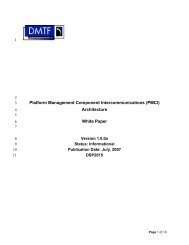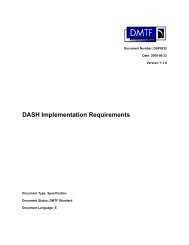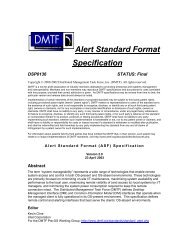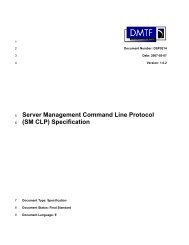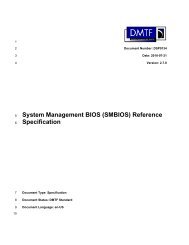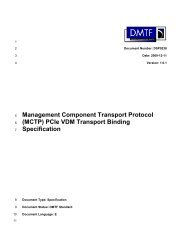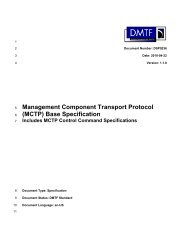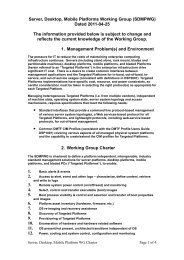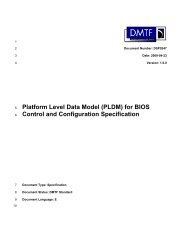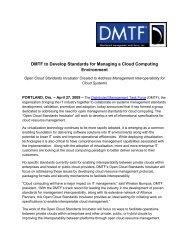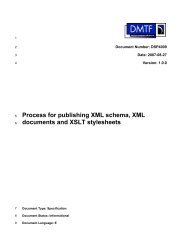DSP0237 - DMTF
DSP0237 - DMTF
DSP0237 - DMTF
Create successful ePaper yourself
Turn your PDF publications into a flip-book with our unique Google optimized e-Paper software.
MCTP SMBus/I2C Transport Binding Specification<br />
<strong>DSP0237</strong><br />
544<br />
545<br />
546<br />
547<br />
548<br />
549<br />
550<br />
551<br />
552<br />
553<br />
554<br />
555<br />
556<br />
557<br />
558<br />
559<br />
560<br />
561<br />
562<br />
563<br />
564<br />
565<br />
566<br />
567<br />
568<br />
569<br />
570<br />
Unless otherwise specified, numeric or bit fields that are designated as reserved shall be written as 0<br />
(zero) and ignored when read.<br />
5.2 Byte Ordering<br />
Unless otherwise specified, byte ordering of multi-byte numeric fields or bit fields is "Big Endian" (that is,<br />
the lower byte offset holds the most significant byte, and higher offsets hold lesser significant bytes).<br />
6 MCTP over SMBus/I 2 C Transport<br />
The MCTP over SMBus/I 2 C transport binding defines how MCTP packets are delivered over a physical<br />
SMBus or I 2 C medium using SMBus transactions. This includes how physical addresses are used, how<br />
fixed addresses are accommodated, how physical address assignment is accomplished for hot-plug or<br />
other devices that require dynamic physical address assignment, and how MCTP support is discovered.<br />
Timing specifications for bus and MCTP control operations are also given, and a "fairness" protocol is<br />
defined for the purpose of avoiding deadlock and starvation/lockout situations among MCTP endpoints.<br />
The binding has been designed to be able to share the same bus as devices communicating using earlier<br />
SMBus/I 2 C management protocols such as Alert Standard Format (ASF) and IPMI, and with vendorspecific<br />
devices using SMBus/I 2 C protocols. The specifications can also allow a given device to<br />
incorporate non-MCTP SMBus functions alongside MCTP. This is described in more detail in 6.20.<br />
6.1 Terminology<br />
According to SMBus, SMBus devices are categorized as follows, where Address Resolution Protocol<br />
(ARP) refers to the SMBus Address Resolution Protocol (a dynamic slave address assignment protocol)<br />
and UDID refers to a "unique device identifier", a 128-bit value that a device uses during the ARP process<br />
to uniquely identify itself. Because these protocols are implemented with command transactions that are<br />
run on top of the SMBus physical specification, it is possible to use these protocols on devices that<br />
support an I 2 C physical interface.<br />
• ARP-capable<br />
SMBus term indicating a device that supports all SMBus ARP commands with the exception of<br />
the optional Host Notify command. The slave address is assignable. The device supports both<br />
Reset commands.<br />
571 • Fixed and Discoverable<br />
572<br />
573<br />
574<br />
575<br />
SMBus term indicating a device supports the Prepare to ARP, directed Get UDID, general Get<br />
UDID, and Assign Address commands. The slave address is fixed; the device will accept the<br />
Assign Address command but will not allow address reassignment. The device supports both<br />
Reset commands.<br />
576 • Fixed - Not Discoverable<br />
577<br />
578<br />
SMBus term indicating a device supports the directed Get UDID command. The slave address<br />
is fixed.<br />
579 • Non-ARP-capable<br />
580<br />
581<br />
SMBus term indicating a device does not support any ARP commands. The slave address is<br />
fixed.<br />
18 <strong>DMTF</strong> Standard Version 1.0.0



